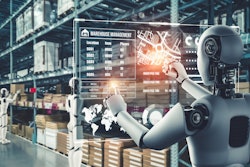
How many times have you used one of these two phrases? “I wish I had a plan B,” or “It's back to the drawing board.” In food manufacturing, especially when dealing with the supply chain, those phrases and others are unfortunately used far too often. Supply chains for all industries have become incredibly complex, but for food and beverage manufacturers, supply chain management is more difficult than ever before.
Transportation issues, market changes, consumer behavior, backlash from pandemic, environmental problems, geo-political factors and many other disruptions have complicated the supply chain. When analyzing the supply chain of food manufacturers, three critical areas need to be discussed.
First and foremost the term “supply chain.” Is it really a chain? If you think about it, the entire supply chain that a food manufacturer needs to manage is actually the coordination of multiple chains that roll up into the supply chain. The three major components of the master chain are distribution, manufacturing and procurement (supply), with each of these areas having smaller supply chains that need to be managed.
The second consideration is that every supply chain has two components that need to operate in unison and be totally synchronized; the physical (inventory and products) and the digital (data and information). The physical supply chain consists of the actual inventory or products at all levels; finished goods, work in process and raw materials. The digital supply chain consists of the data and information that has to flow in unison with the movement of inventory. If these are not synchronized at all times, the shipment of inventory will stop resulting in customer service delays, manufacturing disruptions, and most of all, lost profits.
The third component that complicates all levels of operations today is the expanding value chain of this industry. There are more ways for consumers to get the products they need and desire. Online shopping, same-day delivery, subscriber services, club stores, specialty and convenience stores and even vending machines have expanded to where today one can buy almost anything anywhere. Food manufacturers have never had to deal with so many moving parts and so many value streams. Today's supply chains have more product touch points and more channels, which means there are more places where things can go wrong and disrupt plans.
With the landscape set and all these areas laid out for us to where things can go wrong, what happens next? What can food manufacturers do to be prepared or at least as prepared as possible when plans need to be changed? For example, it is impossible to plan for a global pandemic, right? It is impossible to plan for a recall of a popular product and the shutdown of your primary producing facility, or a fire to a primary producing facility, right? Well, not exactly. While it is impossible to predict if and when those things will happen, start the process of a Plan B, C, D and on and on and have more than one drawing board ready to re-plan if they do happen. With the right processes and tools in place, you can model “what if” scenarios up and down the supply chain, either in its entirety or at select sections and points.
Manufacturers need to open up the planning processes, not just to model what is in front of them, with a base forecast and orders that roll back throughout the supply chain. Manufacturers need to include in that process the ‘what if’ modeling scenarios. What if our forecast doubles or our demand shrinks? What if we gain two new customers or lose three long term ones? What happens if our main supplier goes out of business? Many of these examples are crisis examples, but as seen over the last several years, they can happen without much warning. From plant fires to product recalls, blackboard manufacturers don't make blackboards that big, and excel spreadsheets don’t have the answers either.
The purpose of the supply chain is to satisfy the needs of a manufacturer's final customer. For food manufacturers, it is complex because the customer, for the most part, is a retail organization. However, they need to take into consideration the end consumer. This means that product design, product proliferation, distribution points both current and future as well as manufacturing locations need to be analyzed. Overall capacity requirements, including external sources such as co-packers, need evaluation even if they are only used for emergent situations. Modeling the supply chain helps put in place alternate plans to achieve the goals of the business objectives such as product quality, on-time delivery, lower production and inventory costs, and have the capabilities to manage large and small disruptions. There are a number of key points, questions and scenarios that can be modeled.
● Market growth and demand expansion
● Product proliferation and reduction
● Products to produce or discontinue
● Distribution center and warehouse locations and strategy
● Production facility locations and the use of contract manufacturing
● Transportation lanes
If you think about it, the options are endless. You can alter the number of SKUs you produce and sell, where they are made and model potential business expansion and growth or reduction.
Traditionally most manufacturers, even the global industry leaders relied on spreadsheets to analyze their networks. Today, that is getting more difficult to do, almost impossible to do. Now, there are tools that manufacturers can purchase to do one-off “what if” modeling, but what is needed is more than that to do continuous “what if” scenario planning. Two things are needed; the right process and the right tools.
Start with the process -- sales and operations planning (S&OP). Over the last 30 years, S&OP has evolved and the name has even been changed. Some people call it integrated business planning, others have evolved it to be called sales, inventory operations planning (SIOP). One of the primary stars of a S&OP process is inventory, so SIOP might be the way to go. Regardless of the name, there are a few things that are important to the success of the process. First, is it really a process? Many people think of S&OP as a monthly meeting to discuss plans and that’s it. Some people have a monthly calendar of select events that have to happen in a sequence, and that is S&OP. S&OP, IBP or SIOP is your business philosophy. It is your mindset. Certain events, a meeting or meetings, are just a small part of this philosophy. And, part of this philosophy is having the tools in place to model “what if” scenarios on a daily basis to constantly be ready to break out Plans B, C and D and erase the blackboard.
Once the philosophy is in place, the tools come next. It should start with an adaptive digital supply chain planning system. With all the complexity of the greater supply chain and individual chains, there are areas that need to be analyzed together and separately. An S&OP process and physical software tool can bring it together, but distribution plans, forecasts, production plans and supplier plans all need to be evaluated separately and collectively to make it all come together. In addition, it needs to be done in the cloud for easy connectivity and collaboration; not just within the organization, but also throughout the entire ecosystem.
The benefits of implementing a process that allows you to dynamically model scenarios that can disrupt and alter business plans are almost endless. One of the major benefits of creating a SIOP process and implementing an adaptive supply and demand planning system is to coordinate the interaction of not just your organization, but also your trading partners. This allows you to model many alternate scenarios, save them and refer back if the situation arises. These plans and “what if” scenarios can be modeled around constraints and serve as dress rehearsals for the disruption as they happen. When these situations occur in the future, you won’t wish for a Plan B or a new drawing board. You will have one. In fact, you will have many. Along with the alternate plans, you will have an agile, adaptive supply chain.

















